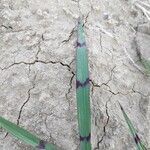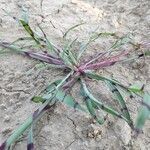Annual, whole plant often purple-tinged. Culms loosely tufted, erect or ascending, 15–40 cm tall. Leaf sheaths loose, usually keeled, glabrous or pilose; leaf blades linear-lanceolate, 5–12 × 0.4–0.8 cm, ± pilose, base subrounded, apex acuminate; ligule ca. 0.6 mm. Inflorescence digitate or on a short axis; racemes 2–4, divaricate, 2–9 cm; spikelets ternate; rachis ribbonlike, winged, 0.8–1.1 mm broad, midrib white, rounded or triquetrous, narrower than the green or purple wings, margins serrulate; pedicels angular, scabrous, tips discoid. Spikelets elliptic, 2–2.2 mm, pilose with verrucose hairs, some with curled tips; lower glume absent or a tiny hyaline rim; upper glume as long as spikelet or slightly shorter, 3–5-veined, intervein spaces and margins appressed-pilose; lower lemma as long as spikelet, 5–7-veined, interveins and margins appressed-pilose; upper lemma purplish brown to blackish at maturity. Fl. and fr. Jun–Nov. 2n = 36.
Plants forming loose tufts, ascending or suberect, only seldom rooting at the lower nodes; herbage glabrous (or the upper margins of the sheaths ciliate); racemes 2–5(–8), 4–10(–15) cm; spikelets elliptic or somewhat obovate, 1.7–2.3 mm; becoming dark brown or purple-black; first glume lacking or minute and hyaline; second glume and sterile lemma equal and as long as the spikelet, both ± pubescent or subtomentose with capitellate hairs, especially in strips between the veins; 2n=36, 45; otherwise much like no. 4 [Digitaria sanguinalis (L.) Scop.]. Native of Eurasia, now established as a weed over much of the U.S., and throughout our range, but less abundant than no. 4. (D. humifusa)


